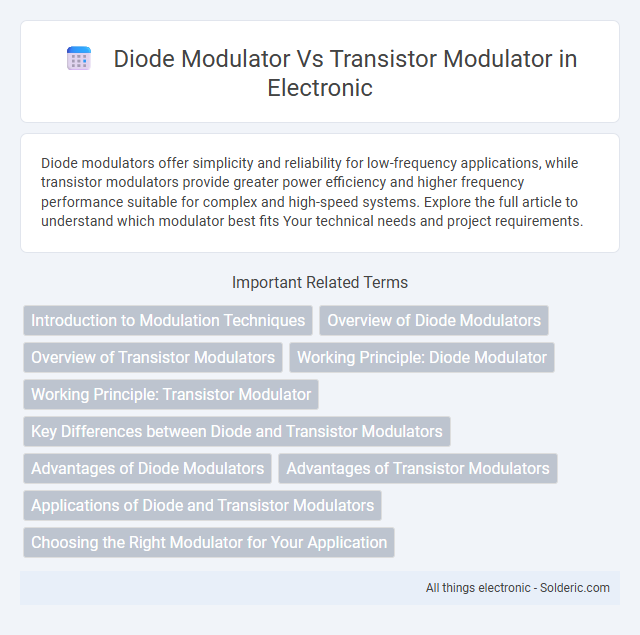Diode modulators offer simplicity and reliability for low-frequency applications, while transistor modulators provide greater power efficiency and higher frequency performance suitable for complex and high-speed systems. Explore the full article to understand which modulator best fits Your technical needs and project requirements.
Comparison Table
| Feature | Diode Modulator | Transistor Modulator |
|---|---|---|
| Component Type | Semiconductor diode | Bipolar junction or field-effect transistor |
| Operation Principle | Varies capacitance or conductivity of diode under control signal | Amplifies and switches signals using transistor gain |
| Modulation Method | Amplitude or phase modulation via diode nonlinearities | Amplitude, frequency, or pulse modulation with transistor switching |
| Switching Speed | Moderate; limited by diode junction properties | High; depends on transistor type and construction |
| Power Handling | Generally lower power capability | Higher power handling, suitable for amplification |
| Linearity | Less linear; nonlinear device behavior | More linear with proper biasing |
| Efficiency | Lower efficiency in modulation | Higher efficiency in switching and amplification |
| Applications | Simpler, low-power RF modulators and mixers | High-performance modulators in communications and broadcasting |
| Cost | Lower cost, simpler design | Higher cost due to complexity and performance |
Introduction to Modulation Techniques
Diode modulators use nonlinear properties of diodes to vary the amplitude or frequency of a carrier signal, offering simplicity and cost-effectiveness in modulation techniques. Transistor modulators leverage the transistor's amplification capabilities to achieve more efficient and linear modulation, suitable for higher power and complex signal applications. Your choice between the two depends on the desired signal quality, power efficiency, and complexity of the modulation system.
Overview of Diode Modulators
Diode modulators utilize semiconductor diodes to vary the amplitude or frequency of a carrier signal by controlling its conduction state, offering high-speed switching with minimal signal distortion. These modulators are preferred in applications requiring compact size, low power consumption, and high-frequency operation due to the diode's intrinsic properties. Compared to transistor modulators, diode modulators typically provide simpler circuit design and better linearity in RF modulation.
Overview of Transistor Modulators
Transistor modulators use semiconductor devices that control current flow through a transistor to modulate signals efficiently, providing higher power handling and faster switching speeds than diode modulators. This technology enables precise amplitude or frequency modulation crucial for RF applications, offering better linearity and thermal stability to enhance overall signal quality. Your communication system benefits from improved signal integrity and reliability when employing transistor modulators, making them ideal for modern high-frequency modulation tasks.
Working Principle: Diode Modulator
A diode modulator operates by varying the amplitude of a carrier signal through the nonlinear resistance characteristic of the diode, which allows it to control the signal without requiring external power. In amplitude modulation (AM), the diode conducts during positive half cycles, effectively mixing the carrier with the modulating signal to produce the desired output. Your choice of a diode modulator ensures simplicity and efficiency in applications where low distortion and minimal power consumption are critical.
Working Principle: Transistor Modulator
Transistor modulators operate by varying the transistor's conductivity through an input signal, enabling amplitude modulation of the carrier wave. The transistor acts as a variable resistor or amplifier, controlling the output signal in sync with the modulating input. This principle allows precise modulation with high efficiency and linearity in communication systems.
Key Differences between Diode and Transistor Modulators
Diode modulators primarily rely on the nonlinear characteristics of semiconductor diodes to vary amplitude or frequency in RF signals, offering simplicity and high-speed switching with low power consumption. Transistor modulators utilize bipolar junction or field-effect transistors to provide greater amplification, linearity, and control over modulation depth, making them suitable for high-power and precision applications. Key differences include power handling capabilities, linearity performance, and complexity, with diode modulators favoring compact, low-power designs and transistor modulators enabling robust, high-fidelity signal modulation.
Advantages of Diode Modulators
Diode modulators offer advantages such as faster switching speeds and lower power consumption compared to transistor modulators, making them ideal for high-frequency applications. Their compact size and simpler circuit design contribute to increased reliability and reduced manufacturing costs. You benefit from enhanced signal integrity and greater efficiency when using diode modulators in communication systems.
Advantages of Transistor Modulators
Transistor modulators offer higher efficiency and greater linearity compared to diode modulators, making them ideal for precise signal control in communication systems. Their ability to handle higher power levels and faster switching speeds ensures improved performance and reliability in various electronic applications. Your system benefits from enhanced modulation accuracy and reduced distortion when using transistor modulators.
Applications of Diode and Transistor Modulators
Diode modulators are commonly used in high-frequency applications such as microwave communication and radar systems due to their fast switching speeds and low distortion. Transistor modulators find extensive use in audio and radio frequency amplification, offering greater linearity and power handling for broadcast transmitters and communication devices. Your choice depends on the required modulation frequency, power levels, and application-specific performance criteria, with diode modulators favoring high-frequency precision and transistor modulators supporting higher power and broader bandwidth.
Choosing the Right Modulator for Your Application
Diode modulators are preferred for high-frequency, low-power applications due to their fast switching speeds and simple design, while transistor modulators excel in high-power, linear amplification environments offering better signal fidelity and gain control. Selecting the right modulator depends on parameters such as frequency range, power requirements, and signal linearity, with diode modulators suited for frequency modulation and transistor modulators ideal for amplitude modulation tasks. Evaluating application-specific needs like efficiency, complexity, and thermal management guides engineers in optimizing performance and reliability.
Diode modulator vs transistor modulator Infographic

 solderic.com
solderic.com